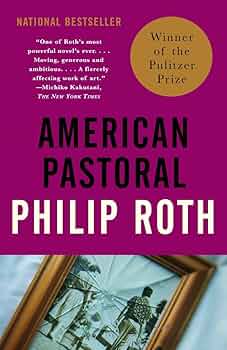In the vast landscape of American literature, few works probe the fractured promises of the nation’s ideal as profoundly as Philip Roth’s American Pastoral. This novel, a poignant exploration of identity, family, and societal upheaval, invites readers to reflect on the elusive nature of the so-called American Dream. In this review, we will delve into Roth’s intricate narrative and thematic layers, unraveling the ways in which American Pastoral challenges and illuminates the postwar American experience with both subtlety and starkness.
Exploring the Complex Layers of Identity and Belonging in Philip Roth’s American Pastoral
Philip Roth delves deep beneath the surface of the American Dream, revealing that identity and belonging are far from monolithic experiences. In American Pastoral, the idyllic façade of the Swede Levov’s life unravels as political unrest and personal tragedy reveal fractured dimensions of self and community. Roth masterfully portrays how identity formation is entangled with societal expectations,cultural tensions,and the relentless pursuit of belonging-each layer unveiling contradictions that challenge the very notion of a unified American experience.
The novel’s exploration can be summarized in three interwoven themes:
- Fragmentation of Identity: the dissonance between public persona and private turmoil.
- Conflict of Generations: how divergent values between parents and children redefine belonging.
- Societal displacement: The pressure exerted by historical and political upheaval on individual stability.
| Theme | Manifestation in narrative |
|---|---|
| Identity Fragmentation | Swede’s perfect image vs.daughter’s rebellion |
| Generational Conflict | Traditional values clash with 1960s radicalism |
| Societal displacement | Political violence disrupts personal dreams |
The Portrayal of Postwar American Optimism and Its Inevitable Cracks Within the Narrative
The cracks in this optimistic veneer are not just personal but emblematic of broader societal shifts. Roth uses symbolism and the characters’ struggles to reflect the fragmentation of national identity in the turbulent 1960s and 70s, marking a period where idealism met harsh realities. The novel suggests that the pursuit of the American Dream is often shadowed by contradictions that challenge its very foundation. Consider this simple breakdown of thematic contrasts Roth weaves into the narrative:
| Theme | Optimistic Portrayal | Underlying Cracks |
|---|---|---|
| suburban Life | Stability & Success | Isolation & Discontent |
| Family | Unity & Tradition | Division & Rebellion |
| National Identity | Prosperity & Progress | Conflict & Fragmentation |
- Hope is depicted as fragile, constantly tested by reality.
- Identity becomes a battleground for competing narratives.
- Change is inevitable but frequently enough resisted, fueling tension.
how American Pastoral Captures the Turbulence of Political and Social upheaval in the 1960s
American Pastoral masterfully encapsulates the upheaval of the 1960s by weaving a deeply personal narrative within the broader tapestry of social unrest. Roth’s protagonist, Seymour “Swede” Levov, serves as a microcosm of the American Dream itself-onc pristine and unblemished, yet increasingly fragmented by the relentless tides of political dissent, generational conflict, and cultural fragmentation. The novel’s exploration goes beyond the visible riots and protests, delving into the corrosive effects on familial bonds and individual identity, highlighting how the era’s turmoil penetrates even the most idyllic suburban facades.
The novel’s portrayal of this turbulent decade is not merely backdrop but an active force, shaping and reshaping lives with brutal unpredictability. Key elements that illustrate this dynamic include:
- The fractured American identity: Through Swede’s idealism clashing with his daughter merry’s radicalism, Roth examines the sudden rupture between past values and emerging countercultural ideals.
- Generational divide: Merry’s violent rebellion against the establishment symbolizes the irreconcilable schism between baby boomers and their parents.
- The silent disintegration of innocence: The novel poignantly captures how societal upheaval seeps into private spaces, eroding trust and innocence.
| aspect | Portrayal in American Pastoral | 1960s parallel |
|---|---|---|
| Idealism | swede’s American Dream | Post-war optimism |
| Rebellion | Merry’s radical activism | Youth counterculture, anti-war protests |
| Loss | Family breakdown | Cultural fragmentation, mistrust in institutions |
The Role of Family Dynamics and Personal Tragedy in Challenging the American Dream Ideal
Through the intertwined threads of personal tragedy and familial discord, Roth suggests that:
- Idealism is vulnerable to the unpredictable forces of human emotion and history.
- generational tensions embody larger cultural and political rifts in America.
- The pursuit of happiness often collides with deeply ingrained personal and collective trauma.
| Family Member | Role in the Dream | Source of Disruption |
|---|---|---|
| Seymour “The Swede” Levov | Symbol of success and stability | Unraveling family image due to daughter’s rebellion |
| Daughter, Merry Levov | Potential for idealism and change | Radical political acts and emotional estrangement |
| Mrs. Levov | Anchor of family unity | Silent suffering and denial |
Narrative Style and Character Development That Enhance the Novel’s Reflective and critical Tone
Philip Roth’s narrative approach in American Pastoral employs a deeply introspective and layered storytelling technique that immerses readers into the fractured American psyche. By utilizing Seymour “Swede” Levov’s son as the primary narrator, the novel creates a distance that allows for broad reflection while maintaining an intimate connection to its main character. This dual perspective enables Roth to dissect the elusive nature of the American Dream-not as a straightforward success story, but as a complex, often contradictory ideal. The narrative’s introspective pacing,coupled with purposeful shifts in tone,underscores the tension between appearance and reality,inviting readers to critically evaluate each character’s decisions and their underlying motivations.
Character development is integral to amplifying the novel’s reflective and critical atmosphere. The multifaceted personalities, from the charismatic Swede to his rebellious daughter Merry, embody the conflicting forces at play in postwar America. Roth crafts each figure with nuance, resisting simplistic heroism or vilification.Rather, the characters’ flaws and contradictions become conduits for exploring broader societal issues such as identity, violence, and disillusionment. This dynamic is epitomized in the following table, which contrasts key character traits and their symbolic implications:
| Character | Key Traits | Symbolic Role |
|---|---|---|
| Seymour “Swede” Levov | Idealistic, stoic, controlled | Embodiment of the postwar American Dream |
| Merry Levov | Rebellious, volatile, idealistic | The fracture of innocence and political unrest |
| Norman Levov | Observant, flawed, reflective | The chronicler of disillusionment |
- Unreliable narration: Invites skepticism and engagement from the reader.
- Complex character arcs: Reflect the evolving American cultural landscape.
- Thematic layering: Connects personal tragedy to national identity crises.
Symbolism and Setting as Windows Into Midcentury American Life and Disillusionment
Philip Roth masterfully employs symbolism and meticulously crafted settings to peel back the layers of midcentury American life, exposing the fractures beneath the glossy surface of postwar prosperity. The decaying American Dream is visually represented not only through the physical spaces-suburban homes, sports stadiums, and factory towns-but also through symbols like the shattered glass at the scene of domestic unrest or the recurring motif of the perfect, yet eerily empty, lawn.These elements serve as more than mere backdrops; they act as silent narrators, echoing the collective anxieties of a society grappling with conformity, racial tensions, and political upheaval during the 1960s and 70s.
Through a palette of carefully chosen symbols and settings,Roth contrasts public idealism with private disillusionment,creating a rich tapestry that reflects the complexities of American identity. Consider the following elements that populate the novel’s landscape:
- The pastoral home: A facade of tranquility masking turbulence beneath.
- Suburban sprawl: An emblem of achievement yet a breeding ground for alienation.
- Riot scenes: Visual representations of societal fractures erupting in chaos.
- Sports arenas: Microcosms of competition, pride, and the bittersweet taste of lost innocence.
| Symbol | Significance |
|---|---|
| Shattered glass | Fragility of the American dream and family unity |
| Empty baseball stadium | Loss of community and traditional values |
| Perfect lawn | Illusion of control and societal expectations |
Recommendations for Readers Seeking Insightful Commentary on America’s Changing Cultural Landscape
For those eager to delve deeper into the complexities of America’s evolving cultural and social narratives, exploring works that blend personal turmoil with historical upheaval proves invaluable. philip Roth’s American Pastoral masterfully captures this dynamic by peeling back layers of the idyllic American dream to expose the cracks borne from political unrest and generational divides. Readers seeking a profound understanding shoudl consider pairing Roth’s novel with contemporary essays and critiques that dissect themes of identity,rebellion,and the fragmentation of idealism in 20th-century America.
To enrich your exploration, here are some thoughtfully curated resources that complement the novel’s themes and provide diverse perspectives on the shifting cultural landscape:
- Essays on Postwar American Identity – Analyses that contextualize societal changes post-world War II, illuminating how historical events shape collective and individual consciousness.
- Interviews with Philip Roth - Insightful discussions that reveal the author’s intentions, creative process, and reflections on American society.
- Documentaries on 1960s America – Visual narratives that capture the unrest and upheaval influencing the era depicted in American Pastoral.
- Comparative Literary Criticism - Studies contrasting Roth’s work with other contemporary American authors who engage with similar themes of disillusionment and cultural change.
| Resource Type | Recommended Title | Why it Matters |
|---|---|---|
| Essay | the Unraveling of the Suburban Myth | Explores postwar idealism’s fragility |
| Interview | Conversations with Roth: Reflections on America | Author insights on societal shifts |
| Documentary | Voices of the 60s: America in Flux | Historical context for cultural upheaval |
| Critical Analysis | Shattered Dreams: Literature and Discontent | comparative look at disillusionment themes |
Comparative Reflections on American Pastoral and Other Landmark American Literary Works
Philip roth’s American pastoral stands as a profound meditation on the elusive nature of the American Dream,weaving its thematic complexity alongside other seminal works such as F. Scott Fitzgerald’s The Great Gatsby and Arthur Miller’s Death of a Salesman. whereas Fitzgerald portrays the Dream’s allure and ultimate decay through Jay Gatsby’s tragic idealism, roth presents a more fractured and intimate portrait, spotlighting the disintegration of identity amidst historical turmoil. Millers’ examination of the struggles of the common man complements Roth’s narrative in its shared focus on personal failure against societal expectations. Together, these works form a tapestry of American disillusionment, framed through distinct narrative lenses and historical contexts.
When juxtaposed, these landmark texts reveal crucial thematic dialogues:
- Illusion vs. Reality: Gatsby’s opulent parties mask his loneliness,Miller’s Willy Loman clings to false hopes,and Roth’s Seymour Levov confronts an unraveling family dynamic.
- Societal Pressure: Each character wrestles with the weight of external expectations-whether social status, economic success, or ideological conformity.
- Historical Reflection: While Fitzgerald and Miller root their narratives in the Jazz Age and post-war America respectively, Roth’s late 20th-century setting probes the aftermath of social upheaval and political unrest.
| Work | Central Theme | Protagonist | Era |
|---|---|---|---|
| American Pastoral | Disintegration of the ideal | Seymour “Swede” Levov | 1960s |
| The Great Gatsby | The decay of the Dream | Jay Gatsby | 1920s |
| Death of a Salesman | Failure of American success | Willy Loman | 1940s |
insights Into How Roth’s Personal Experiences Shape the Themes and Emotional Depth of the Novel
Philip Roth’s intricate weaving of personal history and fiction lends American Pastoral its haunting gravitas. Rooted deeply in Roth’s own experiences growing up in Newark-a city marked by juxtaposition and turmoil-the novel channels an intimate understanding of family fragility and social upheaval. Roth’s conflicted view of the American dream is not merely abstract but emerges from his personal encounters with cultural dislocation, Jewish identity, and the loss of innocence. This backdrop empowers the narrative with a textured emotional depth, as characters wrestle with forces beyond their control, mirroring Roth’s own grappling with the contradictions of his time.
- Jewish heritage: Shapes the moral and existential questions throughout the novel.
- post-war America: Encapsulates the tension between optimism and fragmentation.
- Family dynamics: Reflect internal conflicts and societal shifts in a changing landscape.
Roth’s personal lens exposes the fractures beneath the veneer of suburban perfection, turning his prose into a subtle act of historical and psychological excavation.The emotional turmoil his characters endure echoes Roth’s lifelong engagement with themes of identity, loss, and disillusionment. This personalization of grand social narratives elevates the story from mere critique to a profoundly poignant exploration of what it means to hold an ideal-and watch it unravel before you.
| Personal element | Impact on Novel’s Themes |
|---|---|
| Roth’s newark upbringing | Backdrop of cultural tension and identity crisis |
| Jewish-American experience | Exploration of belonging and alienation |
| Parent-child relationships | Emotional core depicting disillusionment |
| Postwar societal change | Contrast between idealism and reality |
The Enduring Relevance of American Pastoral in Contemporary Discussions About Identity and Society
in contemporary conversations about belonging and societal roles, American Pastoral serves as a literary mirror reflecting key dynamics we still grapple with today. Its relevance is underscored by
themes that continue to provoke thought:
- Conflict between individual desires and communal expectations
- The impact of political and social upheaval on personal identity
- The fragility of idealized narratives within families and communities
- Exploration of generational divides and their consequences
| Aspect | Contemporary Reflection |
|---|---|
| Idealism vs. Reality | Social media portrayals vs. personal struggles |
| Political Fragmentation | Polarized discourse affecting community cohesion |
| Identity Formation | Navigating cultural heritage in a globalized world |
philip Roth as a Master Storyteller: His Literary Legacy and Impact on Modern American Literature
Philip Roth’s storytelling transcends mere narrative; it is indeed a profound excavation of the human psyche laid bare against the tumultuous backdrop of American society. his masterful prose weaves complex characters with intricate moral dilemmas, illuminating the gritty contradictions and raw emotions embedded within the American experience. Roth’s ability to navigate the tension between personal identity and cultural expectation sets him apart as a writer whose influence permeates the fabric of modern American literature. By examining themes of assimilation, disillusionment, and the elusive pursuit of happiness, he crafts stories that not only reflect a nation’s struggles but also challenge readers to confront uncomfortable truths about their own lives.
His literary legacy is marked by bold narrative experimentation and an unrelenting commitment to truth. Roth’s works comfortably inhabit the space between intimate confession and social critique, inviting readers into a world where the personal is invariably political. Consider this brief overview of his storytelling elements, which continue to inspire contemporary writers:
- Psychological depth: Characters grappling with identity and existential crises.
- Cultural commentary: Insight into Jewish-American life and broader American ideals.
- Moral ambiguity: Challenging simplistic notions of good and evil.
- Stylistic innovation: Fluid narrative voices and shifting perspectives.
| Element | Impact |
|---|---|
| complex protagonists | Encourage empathetic engagement and nuanced understanding |
| Layered Themes | Reflect multifaceted societal challenges |
| bold Narrative Structures | Push boundaries of traditional storytelling |
In unraveling the layers of American Pastoral, Philip Roth invites readers into a tapestry woven with the complexities of identity, idealism, and disillusionment. This novel does not offer easy answers but instead challenges us to reflect on the fragile contours of the American Dream itself. As we close the final page, we are left not with definitive conclusions, but with lingering questions-about history, family, and the inexorable pull of change. Roth’s work remains a compelling mirror, reflecting both the fractured past and the unsettled present of America’s ever-evolving narrative.











